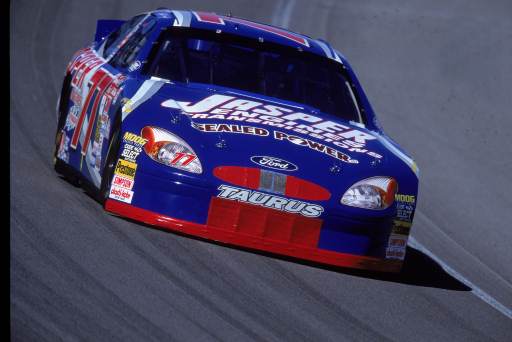Green offers to buy support for rivals.
Jeff Green believes so strongly that NASCAR drivers should be wearing a head and neck restraint device, that he's willing to put his money where his mouth is.
The 2000 NASCAR Busch Series Champion wasn't sure why some drivers were not wearing any type of device, so he decided to do a little investigating. He knew that most full-time NBS regulars were wearing some sort of system, either a HANS device or Hutchins device, but he wasn't sure about the other drivers; the ones competing in the series from time to time, not necessarily every weekend.

Jeff Green believes so strongly that NASCAR drivers should be wearing a head and neck restraint device, that he's willing to put his money where his mouth is.
The 2000 NASCAR Busch Series Champion wasn't sure why some drivers were not wearing any type of device, so he decided to do a little investigating. He knew that most full-time NBS regulars were wearing some sort of system, either a HANS device or Hutchins device, but he wasn't sure about the other drivers; the ones competing in the series from time to time, not necessarily every weekend.
He guessed that the drivers who competed on a limited basis possibly did not have the funds available to purchase a head and neck safety restraint system, especially as the cost for a HANS device can range anywhere from $1500 to $1800, while that of a Hutchins device maybe lower, but is still around $300.
After doing some research with NASCAR, Green found out that his theory was true, as most drivers not using a device were the drivers that did not compete full-time. Green, however, did not want cost to be the reason a driver would not be wearing this essential safety equipment.
"When I found out Blaise Alexander [killed in an ARCA race in the past fortnight] was not wearing any type of head and neck safety device, I got really upset," he said, "I'm not sure if cost was the factor, but I know I have the power to make sure it isn't an issue in the future. So I decided to take it upon myself to offer to pay for a system for any driver who does not have the means to do so for himself. I've been there - I've struggled trying to make it, so I know where they're coming from.
"At Memphis, I made this offer to the drivers in the rookie meeting. I didn't have anyone take me up on purchasing devices for them, but I did motivate three drivers to go out and purchase Hutchins devices for themselves. After purchasing them, they stopped by and asked me how to use them. Another driver had one, but wasn't wearing it because he had questions about using it and I was able to answer those for him. It means a lot to me to that I can help make a difference and motivate these guys to be more serious about their safety and well-being."
Green also addressed other competitors throughout the weekend to stress more diligent use of their head and neck restraint systems.
"I've learned that while many drivers have some sort of safety device, they weren't always using it full-time," he reported, "Some were using it only at the big tracks and some only used it only during races. I want to stress to all drivers that an accident can happen anytime - during practice, qualifying or a race. It also doesn't matter whether you are on a superspeedway or short-track, you still can hit the wall just as hard.
"I just want everyone to be as safe as possible and do everything in their power to make themselves secure in the race car. That doesn't mean we need to adopt every new safety mechanism that comes out, but a head and neck restraint device won't do anything but help them. If I can help make a difference just by letting people know how strongly I feel about this, maybe they will adopt and promote it too."
